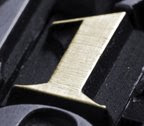 Last week we answered two reader questions and talked about business cards. (Click here to read part three.)
Last week we answered two reader questions and talked about business cards. (Click here to read part three.)Janice Olson left another great question, so let’s start there.
Thanks Dineen, for all the wonderful answers and information. My questions this time are concerning “the” photograph. I have seen different types of professional photographs, but I question which would be the best choice for a one-sheet and business card. Even on your site, there are head, partial, and full body shots on your examples.
My questions:
Would you suggest the same photo be on the card and one-sheet, or should they be different?
Since I see a host of photographs with outdoors or casual settings, and this seems to be the trend, would it look better to have a more casual photograph on the one-sheet? Or on both?
Both are good questions, Janice. In answer your first one, this is really a personal preference. There is a benefit to keeping the same picture on your printed materials to create continuity, but you could use different poses. The background and clothing could be the same but your poses varied. That’s one option. Then for things like blog interviews, you could use a variety of pictures that still hold a connection without becoming redundant.
As for your second question, I strongly recommend you tie this to your genre. For example, if you write chick-lit, doing a portrait that has suspenseful or mysterious tones doesn’t match what you’re writing. Remember, your picture will have some influence on your future reader when they pick up your book in the store. Make a good impression here.
Also, keep in mind that your picture will be small on book jackets and bookmarks. You may have a great picture of yourself set against a lush landscape, but in order to keep you from being the size of a pea in the photo, the layout artist will have to enlarge the photo and crop that excess away so readers can see your face clearly. What may look great in a full background may wind up looking busy and unidentifiable behind your head when cropped. Keep this simple and be sure nothing is poking out from behind your head. You’d be surprised how often this happens. Professional photographers know what to look for and what to avoid.
Overall, whether casual or formal, keep your portrait looking professional. Trust me, whether we realize it or not, most people can spot the difference between a professional shot designed to look candid and casual and a picture taken by a family member or friend.
Colors
I touched on this briefly in part two of this series. Just like your portraits, your colors should mesh with your genre. A color scheme of deep red, black, and white will bring across a sense of danger, suspense, and strength. Great for those thriller and suspense writers. Pastel tones give a sense of happiness and peace—a perfect choice for inspirational writers, some women’s fiction, and children’s books. Bold, loud colors are perfect for chick-lit and lively women’s fiction. I think you get the picture here. Choose colors that convey the theme of your stories. This holds true for your printed materials, as well as your web presence, and is another important aspect of continuity.
Continuity
Creating a common theme between your printed and online materials is like writing a book series. There are elements that carry over from book to book and stay consistent. This will create strong reader identification (also why book series have continuity between covers in their design, colors, fonts, and imagery) and this also speaks a strong but silent message of professionalism.
If you started with your website, carry those designs and colors over to your business card, letterhead, and promotional materials. If you’re a published author and you’re using your current book as a guideline, then your materials to promote that book should match it. Again, this creates strong reader identification. Making connections between advertising materials to the product on the shelf (your book) is vital to a successful promotion. Otherwise, you’re wasting your time. And your money.
Choices: Timely vs. Timeless
This is where your planning will pay off. Literally. Make choices now based upon two things. One, your immediate goal. Are you promoting a book? Then make a “timely” choice.” Design your bookmarks, postcards, and online materials to match in color, design, and even fonts. Order quantities of your printed materials based upon your need. It may be a great deal to spend that extra few dollars just to get 500 more bookmarks, but if you wind up not needing them, then it’s money wasted.
Two, your long term goal. Are you promoting yourself as an author? When making “timeless” choices for your printed and online materials, keep in mind that you will most likely keep this “identity” for two to five years. Can you live with that logo and color scheme that long? Making frequent changes will lose continuity and confuse readers. Choose colors and designs for the long haul. Take advantage of the price break between 250 hundred and 500 business cards if you you’re happy with your image and information, and you will make good use of them. The same can hold true for bookmarks, especially if they’re promoting a series of books, or your books in general.
I hope this series has been helpful. This is just a taste of what I’ll be covering in my Late Night Chat, "Design & Marketing Demystified," at the Conference Friday evening. I hope you’ll come, ready to ask questions and even bring your own materials to share or ask questions. Should be fun!
And feel free to leave any questions. I’ll answer them here in the comments section. See you at conference!










